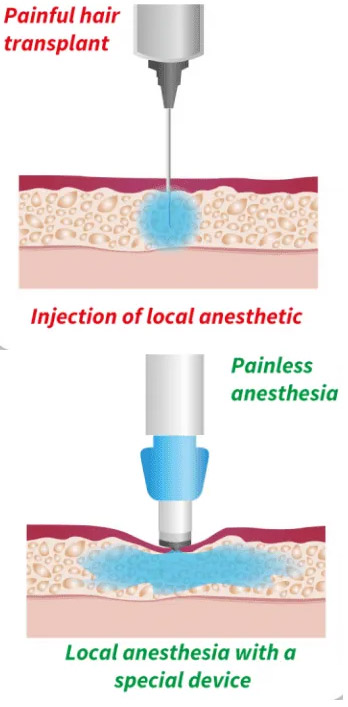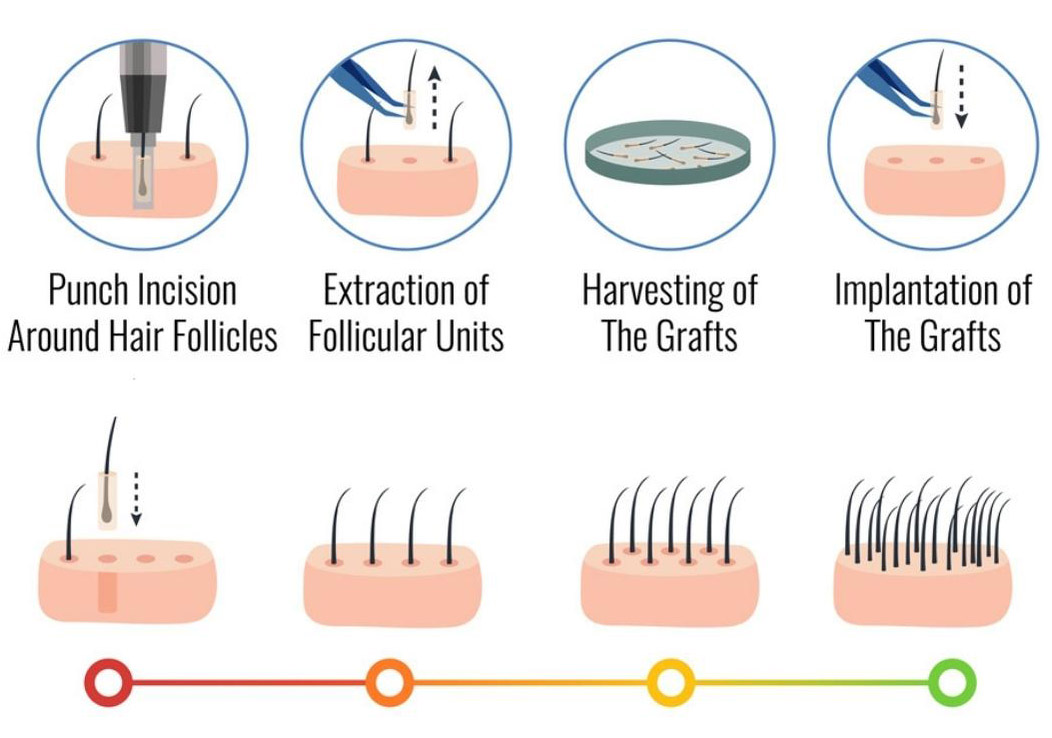Micro Sapphire DHI Hair Transplant – Advanced Hair Restoration Technology
Micro Sapphire DHI Hair Transplant is a state-of-the-art technique that merges the precision of Direct Hair Implantation with the advanced incision quality of sapphire-tipped tools. Designed for individuals seeking natural, dense, and long-lasting results, this method minimizes scalp trauma while maximizing graft survival. With faster healing and refined aesthetic outcomes, it sets a new standard in modern hair restoration.
This guide walks you through the essentials of Afro hair transplants, including the techniques used, unique challenges, and what to expect before, during, and after the procedure. Ready to explore your options? Let’s get started on your journey to fuller, healthier hair tailored to your hair type.
Your Hair Journey at a Glance
Discover the key steps of your personalized hair restoration journey. From consultation to aftercare, we make every step simple and clear for you. Let’s take a closer look at how it all comes together.
Step 1: Free Consultation
Step 2: Hair Analysis
Step 3: Treatment Planning
Step 4: Travel & Procedure
Discover the Truth: 500+ Genuine Patient Reviews Speak for Themselves
See what our patients have to say about their transformative journey and outstanding results with our expert care.
OUR CLINIC & HOTEL
Scientific Hair Transplant Clinic
Understanding the Micro Sapphire DHI Method
Micro Sapphire DHI Hair Transplant is a next-generation hair restoration method that integrates the Direct Hair Implantation (DHI) technique with the refined precision of sapphire-tipped blades. Unlike traditional methods, this technique involves direct implantation of individual hair follicles using tools that minimize trauma, allow for higher graft density, and deliver more natural-looking outcomes.
How It Improves Traditional DHI
The implementation of sapphire blades, instead of steel ones, introduces notable advantages:
- Smaller and more precise incisions that significantly reduce tissue trauma.
- Improved graft survival due to the better orientation and positioning of hair follicles.
- Accelerated healing with fewer scabs and reduced post-operative recovery time.
How Does Micro Sapphire DHI Differ from Traditional DHI?
Key Differences in Technique and Application
While both methods follow the principle of implanting hair follicles directly without creating recipient site incisions beforehand, Micro Sapphire DHI uses ultra-sharp sapphire blades that:
- Enable higher density placement by allowing closer spacing of grafts.
- Reduce the risk of damage to surrounding tissue and follicles.
- Improve control over depth and angle of implantation for natural growth alignment.
Advantages of Sapphire Blades Over Standard Tools
- Cleaner and smoother incisions, reducing trauma to the scalp.
- Enhanced anchoring of grafts, minimizing the risk of dislodgement.
- Antibacterial properties of sapphire contribute to a more hygienic surgical process.
Ensuring Natural-Looking Results with Micro Sapphire DHI
Due to its ability to mimic natural hair angles, this technique is especially effective for front hairline restoration. The fine incisions permit the strategic implantation of single, double, and triple grafts to reconstruct a seamless and full hairline.


Key Benefits of Sapphire Blade Technology in DHI
Increased Precision and Graft Survival Rate
Sapphire blades offer unparalleled accuracy, allowing surgeons to follow natural hair growth patterns. This precision ensures optimal placement and higher graft survival, contributing to long-lasting, visually harmonious results.
Faster Healing Process with Less Scabbing
Thanks to minimal trauma during channel creation, healing is quicker compared to traditional techniques. Patients often experience significantly less swelling and crust formation.
Reduced Trauma to the Scalp, Leading to Minimal Discomfort
The refined tools minimize damage to surrounding tissue, which means:
- Less bleeding during surgery
- Reduced post-operative discomfort
- Shorter recovery time
Natural-Looking and Dense Hairline Creation
With the ability to place more grafts per square centimeter, Micro Sapphire DHI enables surgeons to create dense and aesthetically pleasing hairlines, tailored to each individual’s facial structure and hair growth pattern.
Who is the Ideal Candidate for Micro Sapphire DHI?
Ideal Candidates for This Advanced Technique
This method is best suited for individuals who:
- Have localized or generalized hair thinning or baldness.
- Are seeking high-density and natural-looking hair transplant results.
- Prefer a minimally invasive procedure with a quicker recovery timeline.
- Possess healthy donor hair, particularly in the occipital region.
Addressing Hair Thinning and Baldness
Micro Sapphire DHI is effective for:
- Male pattern baldness (androgenetic alopecia)
- Female pattern hair loss
- Restoring areas affected by traction alopecia or scarring
Minimally Invasive Solution for Long-Lasting Results
This technique provides:
- Permanent hair restoration results
- No need for scalpel or sutures
- A discreet and comfortable patient experience with minimal downtime
Procedure Steps: From Consultation to Recovery
Initial Consultation and Hair Analysis
Personalized Treatment Planning
An in-depth consultation with a specialist includes a detailed assessment of the hairline, donor area quality, and scalp condition. A treatment plan is then developed to meet the patient’s goals.
Evaluating Hair Density and Scalp Condition
Using imaging technology, the doctor examines the density, angle, and thickness of existing hair. This evaluation helps determine the appropriate number of grafts and ideal implantation pattern.
Extraction of Hair Follicles
Advanced Tools for Safe Extraction
Follicles are extracted individually using a high-precision, motorized micro punch device. The extraction is performed in a way that maintains follicle integrity and viability.
Minimizing Damage to Follicles
Sapphire tools ensure minimal pressure and trauma to each graft, thereby reducing the risk of damaging the follicular units and increasing their chances of regrowth.
Implantation Using Sapphire DHI Technique
Precision in Creating Micro-Channels
The sapphire blade is used to create ultra-fine channels that match the direction and depth of natural hair growth. This ensures a stable environment for the new follicles.
Natural Angles for Seamless Hair Growth
Implantation follows the natural angles and curvature of existing hair. This allows the new hair to blend in perfectly, eliminating any visual cues of a hair transplant.
Post-Procedure Care and Recovery Timeline
Immediate Aftercare Instructions
- Avoid direct sunlight and high-heat environments for at least two weeks.
- Do not touch, rub, or scratch the recipient area.
- Use only doctor-approved shampoos and lotions.
- Follow the prescribed medication plan to reduce the risk of infection or swelling.
Hair Growth Timeline and Expected Results
- Weeks 2–4: Temporary shedding phase of transplanted hair (normal and expected).
- Months 3–6: Noticeable new hair growth begins.
- Month 12: Full results with visible thickness and maturity of hair shafts.


Why Choose Micro Sapphire DHI Over Other Hair Transplant Methods?
Comparison with Traditional FUE and FUT Techniques
- FUE: Though minimally invasive, it uses steel blades and requires longer recovery.
- FUT: Involves surgical removal of a scalp strip, leaving a visible linear scar.
- Micro Sapphire DHI: Offers precise, scar-free implantation with faster healing and greater density potential.
Unique Advantages of Sapphire Technology for Superior Outcomes
Patients benefit from:
- Higher implantation density
- Shorter downtime and less post-op discomfort
- More accurate graft placement
- A natural and undetectable final appearance
Micro Sapphire DHI – Frequently Asked Questions
We have compiled the most frequently asked questions about the topics you are curious about. You can contact us for more information.
Micro Sapphire DHI combines the precision of Direct Hair Implantation with sapphire-tipped blades for channel creation. Unlike traditional DHI or FUE methods that use steel blades, sapphire tools allow for finer incisions, resulting in less tissue trauma, denser implantation, and faster healing. This method provides more natural-looking results, especially in hairline design, and is ideal for patients seeking high-density and minimally invasive restoration.
The procedure is performed under local anesthesia, so patients remain awake but experience no pain during the operation. Post-operative discomfort is generally minimal due to the refined nature of the sapphire blades, which reduce bleeding, swelling, and inflammation. Most patients describe the recovery as manageable and far less painful compared to older techniques.
Results develop gradually. After a brief shedding phase within the first 2–4 weeks (a normal reaction called “shock loss”), new hair begins to grow around the 3rd month. Noticeable improvement in density is usually seen by 6 months, with full results—including thickness and natural appearance—typically achieved within 12 to 15 months.
You may be a suitable candidate if you have healthy donor hair on the back or sides of the scalp, experience localized thinning or baldness, and seek a minimally invasive and aesthetically precise solution. This method is also ideal for patients who prioritize natural hairline design, faster healing, and minimal scarring. A clinical consultation is required to assess scalp condition, donor hair availability, and hair loss pattern.
The recovery process is typically smooth and faster than traditional methods. Patients can usually resume non-strenuous daily activities within 1–2 days. Mild redness and scabbing may occur and resolve within a week. It is important to avoid direct sun exposure, heavy exercise, and scratching the scalp. Doctors provide specific aftercare instructions, including how to wash the hair, when to start using shampoos, and what medications to take to ensure optimal graft survival and scalp health.











